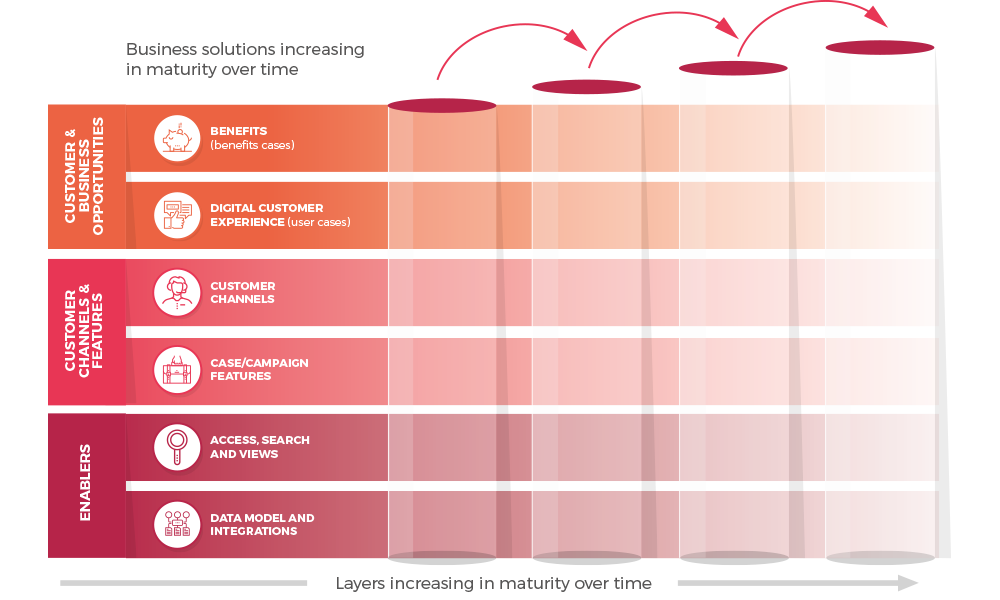Customer relationship management (CRM) is a capability that manages a firm’s interactions with its present and future customers. The global market for CRM applications is growing steadily and will be worth $27 billion by 2021, according to Gartner. Whether consumer or business to business, scaled firms everywhere are seeking ever improved customer interactions, more sales, better internal collaboration, leaner processes and lower costs. The CRM ideal is hard to resist: the system applications on offer are compelling and the likes of Amazon remind us daily how good it can be. But implementation is another matter, and the CRM landscape is littered with projects not fulfilling their original business case or target customer experience. It is fair to say that CRM buyers are still finding their way.
Why does CRM over-promise and under-deliver so often? Because organisations often under-rate the challenges that will get in their way. They focus on technical delivery rather than on the business as a whole, avoiding the business and culture change that’s necessary to drive the promised benefits. They focus on functionality when their priority should be usability for the raft of operations people who rely daily on the CRM tool to serve customers. They pursue the agreed strategic goals but don’t score the quick wins that evolve the system and encourage staff to use it, thus steadily building capability. Marketing, technology and IT speak all the time but still think in silos.
WHERE TO BEGIN
Great CRM combines quality data, technology, business process and ways of working to deliver effortless and meaningful customer experiences. Wrestling all of them together can be overwhelming. Then add the evolution of the business. It’s always moving, which continually presents new challenges for its infrastructure. At no point is CRM completely aligned with the organisation. So CRM envy is common but there is actually no nirvana; with vendor systems the grass is always brown. Nonetheless, there are three crucial points to get right, no matter when you start.
START FROM BOTH ENDS: CUSTOMER EXPERIENCE AND DATA
Firms’ instinctive starting point is the customer experiences (CX) which will deliver the customer benefits and therefore the business case. All this depends on a wide range of users (with varying needs) adopting the system. CRM can’t work if users don’t use it, and they will only use it if the IT works right.
The implication is that the organisation needs to think in two directions at once. It starts with the customer benefits it seeks, but delivering them means starting at the other end – to make sure the system gets the right data to the right place at the right time. No matter how good the CRM system and however well it’s implemented, it’s all for nothing if the underpinning data model is flawed or data quality is poor. For one client, a data model had not been designed with the end in mind. The data model took 12 months to re-engineer with serious implications for the whole programme.
ONE CUSTOMER, MANY SILOS
Brand promises are more easily made than kept because they rely increasingly on deep integration behind the scenes. More common, though understandable, is collaboration between silos that’s only skin deep. CRM is often blighted by projects that unfold in the wrong order and don’t link together, all of which gobbles funds and disappoints customers. This is partly because even departments under the same roof can struggle to find common ground.
The productive conversations between silos begin when each really hears what the other needs. Once they see how their agendas depend on each other, real integration is within their reach, and they can build a common frame of reference for both the problem and the solution.
AND FIRST, ALIGN THE SENIOR STAKEHOLDERS
Efforts to manage vendor systems soon look haphazard if they’re not fully co-ordinated. The key to CRM is a deliberate, mindful plan. The key to that is alignment between the major stakeholders, especially the CMO, CTO and CIO (or their representatives). They come together in a series of carefully structured meetings to decide what the system will do, what it won’t attempt just yet, and where the big interdependencies are, like juggling features vs adoption. To deliver the customer benefits, every solution layer must happen in sync with other parts of the system – from data model to channels to user cases to CX.
Good things flow from this new understanding of complexity: the system becomes more adaptable because its disparate parts are now aligned and optimised; senior stakeholders make choices that serve the customer and business outcomes more reliably; and they’re much better placed to communicate their priorities internally. The result is more clarity across the organisation, from bottom to top and right to left, about how to fulfill the business case.
Making a success of CRM is complex and untidy because it’s so interdisciplinary. It is implemented by people who see the world very differently: marketing looks from the outside in; IT thinks from the inside out. With so many moving parts, it’s not surprising senior operators look for certainties. But they can resist the expedient answers more easily when armed with a framework that bridges benefits, business solutions and technology and data.
GATE ONE CUSTOMER SOLUTION CANVAS™
The Customer Solution Canvas™ is a framework developed by Gate One to help organisations think about, discuss and agree the evolution of the customer landscape. It provides a bridge between benefits, business solutions and technology and data.

About Gate One
Gate One is a specialist business change consultancy. Digitally or otherwise, we co-pilot more meaningful business transformation to deliver change that counts. We provide strategy development and portfolio management, operating model, PPM and change services to some of the world’s most interesting, innovative and influential organisations.
For more information about Gate One, visit gateone.co.uk.

